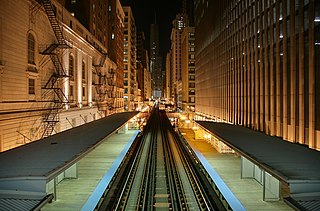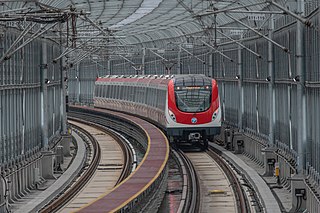
Commuter rail or suburban rail is a passenger rail transport service that primarily operates within a metropolitan area, connecting commuters to a central city from adjacent suburbs or commuter towns. Commuter rail systems can use locomotive-hauled trains or multiple units, using electric or diesel propulsion. Distance charges or zone pricing may be used.

Veolia Transport was the international transport services division of the French-based multinational company Veolia until the 2011 merger that gave rise to Veolia Transdev, later renamed Transdev. Veolia Transport traded under the brand names of Veolia Transportation in North America and Israel, Veolia Transport, Veolia Verkehr in Germany and with the former name Connex preserved in Lebanon, Melbourne and Jersey.

Urban rail transit is a wide term for various types of local rail systems providing passenger service within and around urban or suburban areas. The set of urban rail systems can be roughly subdivided into the following categories, which sometimes overlap because some systems or lines have aspects of multiple types.

Kinki Sharyo Co., Ltd. is a Japanese manufacturer of railroad vehicles based in Osaka. It is an affiliate company of Kintetsu Corporation. In business since 1920 as Tanaka Rolling Stock Works, and renamed The Kinki Sharyo Co., Ltd in 1945, they produce rolling stock for numerous transportation agencies, ranging from Shinkansen high-speed trains to light rail vehicles. Kinki Sharyo is listed on the Tokyo Stock Exchange as TYO: 7122.

CRRC Zhuzhou Locomotive Co., Ltd. is one of the electric locomotive manufacturers in China. It is one of the subsidiaries of CRRC.

China Railway Shanghai Group, officially abbreviated as CR Shanghai or CR-Shanghai, formerly, Shanghai Railway Administration is a subsidiaries company under the jurisdiction of the China Railway. The railway administration was reorganized as a company in November 2017.

Urban rail transit in India plays an important role in intracity transportation in the major cities which are highly populated. It consists of rapid transit, suburban rail, monorail, and tram systems.

Ningbo Rail Transit, also known as the Ningbo Metro, is a rapid transit system serving the city of Ningbo, Zhejiang and its suburbs. Six metro lines are being built inside the urban area of Ningbo, serving Haishu, Jiangbei, Zhenhai, Beilun and Yinzhou. The first phase of Line 1 started construction in June 2009 and began to service the public on May 30, 2014. Line 2 began service on September 26, 2015.

The CRH6 is a regional/commuter higher-speed train of the People's Republic of China. It is designed by CRRC Qingdao Sifang and will be manufactured by CRRC Nanjing Puzhen at its subsidiary, the CRRC Guangdong Jiangmen Factory. Unlike other CRH types, most CRH6 trains use unique names; only very few CRH6 use Hexie as the train name.
The Willis Avenue station was an elevated rapid transit station of the Willis Avenue Spur that branched off of the IRT Third Avenue Line in the Bronx, New York City. It opened in 1886 and closed in 1924.

Line 2 of Ningbo Rail Transit is a rapid transit line in Ningbo. It stretches from Ningbo Lishe International Airport in the southwest towards Zhenhai District in the northeast of the city and further run into Honglian station in Beilun District. The line started service on 26 September 2015.

Ningbo Railway Station is an underground metro station of Line 2 and Line 4 in Ningbo, Zhejiang, China. It situates under the station building of Ningbo Railway Station of China Railways. Passengers can transfer to intercity trains without going out of the station. Construction of the station started in late 2010, Line 2 station opened to service on September 26, 2015, and Line 4 station opened to service on December 23, 2020.

Shanghai Suburban Railway (上海市域铁路) is a network of regional railways radiating or surrounding the city of Shanghai, China. It is a plan for the gradual implementation of a regional rail system across the metropolitan area. The system will eventually connect with Jiangsu Yangtze MIR and Hangzhou Greater Bay Area network.

Ningbo–Yuyao intercity railway is a commuter rail service in Ningbo, Zhejiang, part of the planned Ningbo Intercity Railway network. It runs from Ningbo railway station in Haishu District to Yuyao railway station in Yuyao on the existing Xiaoshan–Ningbo railway. There are also through operation to Shaoxing Tourism New Transit railway. Passengers can transfer to Line 2 and Line 4 of Ningbo Metro at Ningbo railway station.

Taizhou Rail Transit is an urban rail transit system in Taizhou, Zhejiang Province, China. The system is operated by Taizhou Rail Transit Construction and Development Co., Ltd. In the near term, two lines, S1 and S2, are planned; in the long term, lines S3 and S4 are planned.














